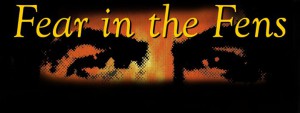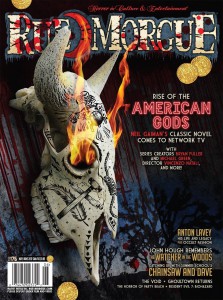 I was interviewed for a feature on America’s ‘black pope’, arch-Satanist Anton LaVey, in the new edition of the excellent horror magazine RUE MORGUE. I was in good company, with the current high priest of the Church of Satan Peter Gilmore, and occult author Carl Abrahamsson also giving their perspectives on LaVey’s life and legacy. (Carl’s book on the Church of Satan in the 60s – CALIFORNIA INFERNAL – is also well worth seeking out.) For more information on RUE MORGUE and to lay your hands on a copy, click here.
I was interviewed for a feature on America’s ‘black pope’, arch-Satanist Anton LaVey, in the new edition of the excellent horror magazine RUE MORGUE. I was in good company, with the current high priest of the Church of Satan Peter Gilmore, and occult author Carl Abrahamsson also giving their perspectives on LaVey’s life and legacy. (Carl’s book on the Church of Satan in the 60s – CALIFORNIA INFERNAL – is also well worth seeking out.) For more information on RUE MORGUE and to lay your hands on a copy, click here.
Category Archives: Uncategorized
The Horror of Wax Waning
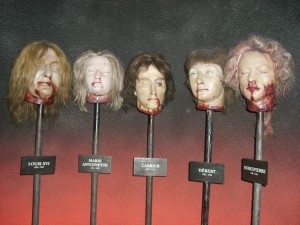 I somehow felt compelled to write something on this. As, on April 11th last year, the Madam Tussauds Chamber of Horrors closed down, and nobody seemed to care. There was no fanfare, no protest, no indication in the media that I can find that this had happened at all. I have a special passion for waxwork museums (which I’ll explore in the second half of this blog) but even without that, it seemed to me that something significant at the core of our cultural heritage had died, wholly unmarked and unmourned. Some two centuries of London tradition deleted with the click of mouse from a Powerpoint presentation at some corporate marketing meeting. There was no official statement on the closure from Madam Tussauds that I could find. Just the following bald statement:
I somehow felt compelled to write something on this. As, on April 11th last year, the Madam Tussauds Chamber of Horrors closed down, and nobody seemed to care. There was no fanfare, no protest, no indication in the media that I can find that this had happened at all. I have a special passion for waxwork museums (which I’ll explore in the second half of this blog) but even without that, it seemed to me that something significant at the core of our cultural heritage had died, wholly unmarked and unmourned. Some two centuries of London tradition deleted with the click of mouse from a Powerpoint presentation at some corporate marketing meeting. There was no official statement on the closure from Madam Tussauds that I could find. Just the following bald statement:
‘The chamber closed until further notice on 11 April 2016, due to many complaints from families with young children.’
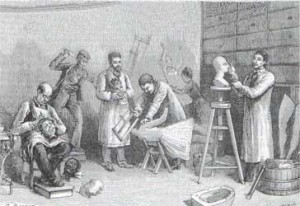 Yet they should have said something. For, whatever you may feel about the morbid character of the Chamber of Horrors, as much as a visit to Madame Tussauds Waxworks has been a must for visitors to London for generations, the Chamber represents the dark foundation of the institution, hooking it bloodily into European history. Our story begins with a French physician named Dr Philippe Curtius, who became skilled in creating wax models to illustrate anatomy. In 1765 the good doctor decided to abandon medicine and dedicate himself entirely to the art of sculpting human figures in wax. His displays were a huge success and by 1770 he had a permanent wax museum in Paris. Curtius’s Caverne des Grands Voleurs (Cavern of the Great Thieves) opened twelve years later, showing the likenesses of notorious criminals, often taken from their executed cadavers, and was similarly successful.
Yet they should have said something. For, whatever you may feel about the morbid character of the Chamber of Horrors, as much as a visit to Madame Tussauds Waxworks has been a must for visitors to London for generations, the Chamber represents the dark foundation of the institution, hooking it bloodily into European history. Our story begins with a French physician named Dr Philippe Curtius, who became skilled in creating wax models to illustrate anatomy. In 1765 the good doctor decided to abandon medicine and dedicate himself entirely to the art of sculpting human figures in wax. His displays were a huge success and by 1770 he had a permanent wax museum in Paris. Curtius’s Caverne des Grands Voleurs (Cavern of the Great Thieves) opened twelve years later, showing the likenesses of notorious criminals, often taken from their executed cadavers, and was similarly successful.
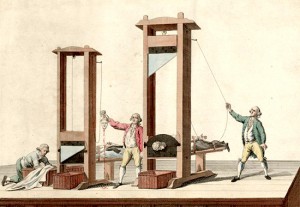 Unusually perhaps, the doctor took a young girl under his wing as his apprentice, named Marie Grosholtz, she was the daughter of his housekeeper. Marie referred to Curtius as ‘uncle’ and soon proved to be an eager, able sculptor in her own right. By 1780, their work began to enjoy approval at the highest levels of French society. They were even invited into the household of Louis XVI. But then, in 1789, history intervened in the bloodthirsty shape of the French Revolution. The next time Marie would encounter the royal family, it was as decapitated corpses. Not long after the Revolution began, her royal association had led to Marie’s arrest as a suspected Royalist. She even got as far as having her head shaved in preperation for her own appointment with the guillotine, when her skills saved her.
Unusually perhaps, the doctor took a young girl under his wing as his apprentice, named Marie Grosholtz, she was the daughter of his housekeeper. Marie referred to Curtius as ‘uncle’ and soon proved to be an eager, able sculptor in her own right. By 1780, their work began to enjoy approval at the highest levels of French society. They were even invited into the household of Louis XVI. But then, in 1789, history intervened in the bloodthirsty shape of the French Revolution. The next time Marie would encounter the royal family, it was as decapitated corpses. Not long after the Revolution began, her royal association had led to Marie’s arrest as a suspected Royalist. She even got as far as having her head shaved in preperation for her own appointment with the guillotine, when her skills saved her.
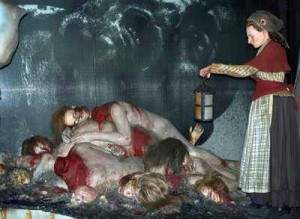 Under literal pain of death, Marie was ordered to make wax models of the heads of decapitated aristocrats – many of them former patrons and friends that she had to find for herself from among the piles of cadavers – for public display. According to one story, the originals kept rotting and falling off their appointed spikes, necessitating more durable, convincing artificial alternatives. By 1795 the worst savage excesses of the French Revolution had passed and Marie had found herself a husband, an engineer named Francois Tussaud. Dr Curtius had died the preceding year, leaving all of his wax models to his protege, and Madame Tussauds Waxworks was born (the apostrophe in Tussaud’s was abandoned some time ago). In 1802 they took the show on the road, crossing the Channel to bring their waxworks to an English audience.
Under literal pain of death, Marie was ordered to make wax models of the heads of decapitated aristocrats – many of them former patrons and friends that she had to find for herself from among the piles of cadavers – for public display. According to one story, the originals kept rotting and falling off their appointed spikes, necessitating more durable, convincing artificial alternatives. By 1795 the worst savage excesses of the French Revolution had passed and Marie had found herself a husband, an engineer named Francois Tussaud. Dr Curtius had died the preceding year, leaving all of his wax models to his protege, and Madame Tussauds Waxworks was born (the apostrophe in Tussaud’s was abandoned some time ago). In 1802 they took the show on the road, crossing the Channel to bring their waxworks to an English audience.
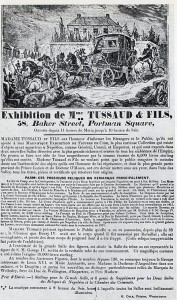 ‘Her odyssey was amazing at the time, when almost no married women worked, and when travelling even a short distance was arduous,’ observed Tussaud biographer Pamela Pilbeam in an article for Business History. ‘Marie remained on the road for nearly 33 years in total, visiting 75 main towns and some smaller places. The packing and unpacking alone, without the travelling, and model and costume making, would have been herculean tasks for a young person, but Marie set out when she was already middle-aged, with a tiny child, knowing noone and speaking not a word of English when she began.’ The English exhibitions were a resounding success, but the Napoleonic Wars prevented the Tussauds from returning to France for some time. Abandoned by her husband by this point, Marie decided to relocate, finally taking up permanent residence in London’s Baker Street in 1835.
‘Her odyssey was amazing at the time, when almost no married women worked, and when travelling even a short distance was arduous,’ observed Tussaud biographer Pamela Pilbeam in an article for Business History. ‘Marie remained on the road for nearly 33 years in total, visiting 75 main towns and some smaller places. The packing and unpacking alone, without the travelling, and model and costume making, would have been herculean tasks for a young person, but Marie set out when she was already middle-aged, with a tiny child, knowing noone and speaking not a word of English when she began.’ The English exhibitions were a resounding success, but the Napoleonic Wars prevented the Tussauds from returning to France for some time. Abandoned by her husband by this point, Marie decided to relocate, finally taking up permanent residence in London’s Baker Street in 1835.
‘Exhibitions illustrating the iniquities of the Revolution were popular in Britain,’ Pamela Pilbeam, notes. ‘What made Marie’s unique was that she and Curtius had made the figures from the living, or dead, bodies of their subjects. For the first time, English audiences could really see the features of the guillotined king and queen, whose deaths they had mourned.’ Londoners could gaze upon wax figures actually cast from executed aristocrats and monarchs, figures that embodied the ethos that would drive Madame Tussauds for the best part of two centuries – a mixture of celebrity, history and morbidity. The ethos casually abandoned in the recent closure of the Chamber of Horrors…
Madame Tussauds hasn’t always had a Chamber of Horrors, even if it has always displayed horrific waxworks. Originally it was simply known as the ‘Separate Room’ in recognition that it was separated from the other less harrowing displays. Nobody was obliged to go in – which has always been the case – putting those ‘complaints from families with young children’ which led to the recent closure of the Chamber of Horrors in context. But more of that anon… There is some controversy as to when the Separate Room became the Chamber of Horrors. Some say the term was first coined in an 1845 article in the humorous magazine Punch, though others maintain Marie had been using the term herself for at least a year before then.
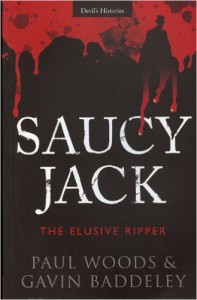 Regardless, the same meticulous dedication to veracity prevailed which had distinguished the grislier displays she had brought with her from the French Revolution when preparing new inhabitants for her Chamber of Horrors. Allow me to quote from my own book, SAUCY JACK, co-authored with true crime expert Paul Woods…
Regardless, the same meticulous dedication to veracity prevailed which had distinguished the grislier displays she had brought with her from the French Revolution when preparing new inhabitants for her Chamber of Horrors. Allow me to quote from my own book, SAUCY JACK, co-authored with true crime expert Paul Woods…
In addition to working from life wherever possible, Tussaud’s went to considerable effort and expense to obtain authentic artefacts relating to the cases they featured – from clothes actually worn by the accused to furniture or even structural elements from the scene of the crime, which would go on display alongside the completed figure.
Such attention to detail and concern for veracity not only strengthened the claims of Madame Tussaud’s to represent a museum rather than a ghoulish freak show, but also lent the Chamber of Horrors a strange, almost totemic quality – the visitor walking among the exhibits would almost literally be rubbing shoulders with killers.
The attraction was a huge success, drawing visitors as eminent as the Duke of Wellington and Queen Victoria, and the introduction of a notable new criminal to the collection was like an opening night, with queues curling out of the building to catch a chilling glance of the Chamber’s newest inmate. Not everybody was a fan. William Thackeray Makepeace fretted over the addition to the Chamber of effigies of Frederick and Maria Manning, sent to the gallows in 1849 for the murder and robbery of an elderly friend of theirs. “Should such indecent additions continue to be made to this exhibition the ‘horrors’ of the collection will surely predominate,” the author fretted. “It is painful to reflect that although there are noble and worthy characters really deserving of being immortalised in wax, these would have no chance in the scale of attention with thrice-dyed villains.”
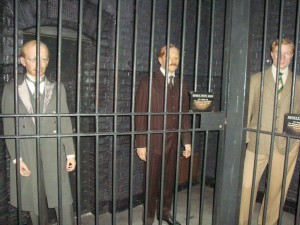
It’s an argument that echoes to this day relating to the depiction of violence in the media. Does it inspire criminality, as some contend, or act as a cathatric safety valve? The Victorian public continued to vote with their feet and, after Madame Tussaud died in 1850, her sons Francis and Joseph expanded the Chamber of Horrors the following year to cater for the popularity of exhibits like the Mannings, displayed alongside an effigy of their victim and a scale model of the room in which he was murdered. In an attempt to stave off criticism, the Tussauds assured visitors that “so far from the exhibition of the likenesses of criminals creating a desire to imitate them, experience teaches that it has a direct tendency to the contrary.” Reliably confirming or contesting such claims has challenged generations of criminologists, psychologists and sociologists.
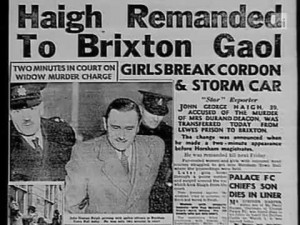 John George Haigh, the Acid-bath Murderer, visited Madame Tussaud’s Chamber of Horrors on the day before his arrest in 1949. Haigh subsequently became a popular exhibit, bequeathing a suit of clothes to Tussaud’s for the display. Peter Sutcliffe, the Yorkshire Ripper, is reported to have been a boyhood regular at the waxworks in Blackpool, particularly favouring a macabre anatomical display. If a visit to the Chamber of Horrors was really the first step on the road to Hell, you would expect a queue to the scaffold to mirror those that formed outside Madame Tussaud’s when a new horror was due to be unveiled. But no such symmetry has ever been observed.
John George Haigh, the Acid-bath Murderer, visited Madame Tussaud’s Chamber of Horrors on the day before his arrest in 1949. Haigh subsequently became a popular exhibit, bequeathing a suit of clothes to Tussaud’s for the display. Peter Sutcliffe, the Yorkshire Ripper, is reported to have been a boyhood regular at the waxworks in Blackpool, particularly favouring a macabre anatomical display. If a visit to the Chamber of Horrors was really the first step on the road to Hell, you would expect a queue to the scaffold to mirror those that formed outside Madame Tussaud’s when a new horror was due to be unveiled. But no such symmetry has ever been observed.
Despite this, Madame Tussaud’s descendents continued to endeavour to defend the propriety of their Chamber of Horrors. In the 1870s her grandson Joseph made a valiant effort to rename it the Chamber of Comparative Physiognomy. Physiognomy – the ancient art of determining character according to facial characteristics – was popular in the day, and if Joseph Tussaud might have legitimately claimed some scientific value to his exhibits in attempting to identify a distinctive criminal ‘look’. To make such a claim plausible, the models had to be as close to their inspiration as humanly possible.
The Chamber of Horrors seemed on safe ground when SAUCY JACK was published in 2009 – I never imagined that such a long and distinguished – albeit macabre – tradition might disappear as it did with so little ceremony last year. In 1996 the Chamber enjoyed a $1.5 million revamp, though the French Revolution death masks and John George Haigh – complete with original suit – remained unchanged. But things have changed. In 1977 Tussauds was no longer a family concern after being taken over by the Pearson corporation, the first of a series of company mergers and takeovers, that saw Madame Tussauds fall into the hands of the Merlin Entertainments company with the Tussauds Group effectively dissolved in 2007.
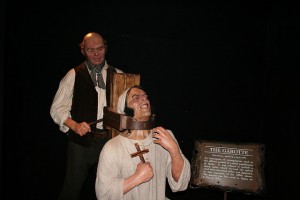
This may explain other developments in the Chamber of Horrors. Merlin took over London’s other major macabre tourist attraction, the London Dungeon, in 1992. Founded in 1974, the London Dungeon had originally been a traditional waxwork museum, focused on horrific historical tableaux. Under Merlin, the London Dungeon began replacing the waxworks with themed rides and live actors in period costume. Recent years saw the Chamber of Horrors following a similar policy of introducing actors to supplement the museum’s traditional inanimate exhibits. Yet none of this hinted at the decision to close the Chamber in 2016.
Perhaps, once the company owned both Tussauds and the Dungeon the business decision was simply made to focus all of their ghoulish displays in one franchise, meaning that a Chamber of Horrors in Tussauds seemed superfluous. Perhaps the Chamber of Horrors was deemed the least popular, and hence profitable, aspect of Tussauds – though the idea that our appetite for the macabre was suddenly sated after two centuries seems improbable to say the least. Sadly, it does seem most likely that the sanitising tendency of corporate culture is the most likely culprit. That a few complaints from entitled, sanctimonious parents who hadn’t even experienced the Chamber of Horrors (it was called the Separate Room for a reason – originally you had to pay extra!) were enough to trigger the corporate reflex to keep the brand’s reputation anodyne and squeaky clean at all costs.
And what’s replaced it? There are now two dozen franchised Madame Tussauds across the globe – none of which at a cursory glance feature a Chamber of Horrors. We live in a globalised world with shared values, many of which are not especially encouraging. Without access to floor-plans it’s hard to say what now occupies the space once occupied by Marie’s morbid exhibits or ponder upon the fate of John George Haigh’s suit. It doesn’t really matter I suppose. What is important perhaps is what is now considered a more compelling attraction for today’s sensation-seekers. It would seem that morbidity – and indeed history – have almost wholly given way to celebrity.
 Perhaps the most horrific chamber in today’s Madame Tussauds is the Youtube display. ‘Enter into the digital world of YouTube and meet two of Britain’s most popular vloggers, Zoe Sugg (Zoella) and Alfie Deyes (PointlessBlog),’ promises the official website. ‘Step into the epicentre of the Zoe and Alfie’s “vlogsphere” and sit beside their likenesses in an exact replica of their spare bedroom, where both often vlog from. Not only were Zoe and Alfie closely involved with the creation of their wax figures and recreating their “vlogsphere”, with a donation of the Ruby Ruth Dolls that appear in the background of many of her vlogs, but so were their fans. Voting on the lipstick her wax figure would wear, as well as picking out which colour t-shirt Alfie should be dressed in – the final poll revealed that Zoe would wear Kate Moss 107 by Rimmel and Alfie a speckled grey t-shirt.’
Perhaps the most horrific chamber in today’s Madame Tussauds is the Youtube display. ‘Enter into the digital world of YouTube and meet two of Britain’s most popular vloggers, Zoe Sugg (Zoella) and Alfie Deyes (PointlessBlog),’ promises the official website. ‘Step into the epicentre of the Zoe and Alfie’s “vlogsphere” and sit beside their likenesses in an exact replica of their spare bedroom, where both often vlog from. Not only were Zoe and Alfie closely involved with the creation of their wax figures and recreating their “vlogsphere”, with a donation of the Ruby Ruth Dolls that appear in the background of many of her vlogs, but so were their fans. Voting on the lipstick her wax figure would wear, as well as picking out which colour t-shirt Alfie should be dressed in – the final poll revealed that Zoe would wear Kate Moss 107 by Rimmel and Alfie a speckled grey t-shirt.’
It would doubtless be gratuitous at this point to start any critique of the cretinous cult of pointless celebrity or indeed underline how Youtubers like Sugg and Deyes embody it. Sadly, it is the world we live in and there is no shortage of meditations on the topic. It might however be valid to pause for a moment to think about how waxworks have reflected its rise. Madame Tussauds is now a selfie facility – a temple to vacuous aspiration. Nobody went to the Chamber of Horrors wanting to pretend to rub shoulders with poisoners at fashionable parties or fancy themselves on the scaffold awaiting decapitation. So why did we go? Is our morbidity really any better than the slackjawed sycophancy feeding the Youtuber fan phenomenon? I’ll think about that in an upcoming piece.
In the meantime, I’d like to take this opportunity to raise a glass in rememberance of the Chamber of Horrors. At the very least, you deserved a more dignified wake…
Alien Descends on York…
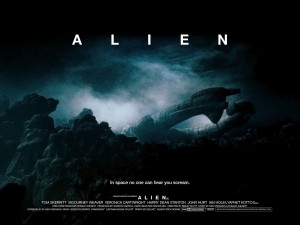 A quick heads up to any genre film fanatics living in the north of England. I’ve got together with some friends to screen Ridley Scott’s horror-sci fi masterpiece ALIEN in York at midday on Saturday 18th of February. We’ll be taking over one of the screens at City Screen, so it will be on state-of-the-art sound and projection equipment, making this a rare opportunity to appreciate this truly iconic film as it was intended, on the big screen. The idea for the screening began as a way to celebrate the upcoming wedding of a film-loving friend, but we quickly decided we wanted this to be a public screening, open to fellow fans. Matters took a poignant turn with the recent death of John Hurt, who gives a standout performance in the film, and we thought screening it like this also offered the perfect way to pay tribute to one of Britain’s greatest ever acting talents.
A quick heads up to any genre film fanatics living in the north of England. I’ve got together with some friends to screen Ridley Scott’s horror-sci fi masterpiece ALIEN in York at midday on Saturday 18th of February. We’ll be taking over one of the screens at City Screen, so it will be on state-of-the-art sound and projection equipment, making this a rare opportunity to appreciate this truly iconic film as it was intended, on the big screen. The idea for the screening began as a way to celebrate the upcoming wedding of a film-loving friend, but we quickly decided we wanted this to be a public screening, open to fellow fans. Matters took a poignant turn with the recent death of John Hurt, who gives a standout performance in the film, and we thought screening it like this also offered the perfect way to pay tribute to one of Britain’s greatest ever acting talents.
For tickets and further information, click here.
Some Final Shameless Self-Promotion for 2016
There are doubtless more than enough autopsies of 2016 taking place at the moment. Like most, I wasn’t over-impressed by 2016, a year that will likely go down in history as the one where raw stupidity prevailed, propelling us all up Shit Creek, not only without a paddle, but without much of a boat to speak of.
Yet on a personal level, I’ve had much to be thankful for in 2016, with many warm memories to reflect upon. Among the highlights was an opportunity to travel to New York and finally meet my friend and collaborator Christopher JC in person, where I had the singular honour of taking part in his wedding to his charming wife. While there, we conducted a number of interviews – some more informal than others. Definitely fitting into the informal category is the chat we had on my final night, where we covered Satanism in the broadest sense. We also drank each other’s health into the early hours, as may be somewhat apparent in my case, but I think the ideas flowed nearly as freely as the ale!
I feel such conviviality appropriate on a night like tonight, and hope you will forgive me posting something where I feel the presenter far too kind in his assessment of my humble abilities. Perhaps trying to live up to such generous praise might be a good aim for 2017.
Meanwhile, do check out Christopher’s excellent site, here, where you can find the rest of this discussion, plus a host of other interviews, essays, art and more on the subject of Romantic Satanism.
Salut!
I Had a Rough Day at Work – Santa Got Murdered
Just a quick note to hope that everyone out there is enjoying whatever they’re doing at this curious time of year. If you’re at a loose end, I compiled a list of my favourite Yuletide horror movies for the cool folk at Alchemy Gothic, which you can check out here. And if you’re going to watch one film this Christmas, then make it ELVES!
Abertoir 2016 Part Two – Vegan Veterinary Students and Socially Responsible Sociopaths
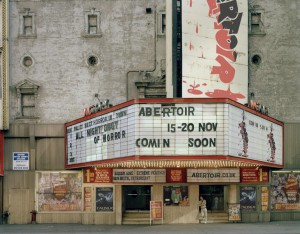
There’s something a bit special, something deliciously, addictively odd about the Welsh horror festival Abertoir. Part of it comes from the paradoxical combination of an insanely acute attention to detail and a laid-back, friendly attitude from the organisers. But the setting also plays its part, as Aberystwyth itself almost invariably contributes its own ineffable oddness to proceedings. In 2016 it came most obviously in the shape of a freak weather front, that sent a sudden salvo of tornadoes across the town halfway through the week.
It looked briefly like the venue would be lifted aloft with all of us inside it, in true WIZARD OF OZ style, before we were all deposited somewhere in Transylvania. Sadly it wasn’t, and the storm evaporated as quickly as it had appeared, though the special showing of THE FOG had to be abandoned. Due to inclement weather, of course. Happily, another venue was found to screen THE FOG, and there were still numerous excellent events to look forward to. As in the first part of my Abertoir rundown – which you can read here – I will be focussing solely on the new films previewed during the week in the hope that this piece can serve as a guide for the best new horror films for fans to look out for in the future…
 I fear I’ll subvert that goal straight away with DEADMAN INFERNO: TOKYO YAKUZA APOCALYPSE, but I do have an excuse. In 2015, the madcap Japanese gangster zom-com mash-up DEADMAN INFERNO won the Audience Award for best new film of the festival. So when the Abertoir organisers discovered that a prequel had subsequently been made, they set out to secure a copy. It turned out to be something of a challenge, as not only had this prequel not been shown outside Japan, even in its homeland it was a limited release. Undeterred, they secured a screening copy, and of course then had to translate it themselves. So the Abertoir showing of DEADMAN INFERNO: TOKYO YAKUZA APOCALYPSE was a real exclusive, the only subtitled version in existence. As it depicts events preceding the zombie outbreak in DEADMAN INFERNO, there are no walking dead. Taking their place is more of the slapstick gore and violence that made the original such a crowd-pleaser, as a brutal gangster clan tries to muscle in on the territory of a Tokyo rival. It is ridiculous, brutal fun, though at just over an hour with no undead, is more of a supplement to it’s feature length predecessor than a film in its own right. If DEADMAN INFERNO ever secures a Blu-ray release though, TOKYO YAKUZA APOCALYPSE would represent the most killer extra ever. And in the context of the festival, it was yet more evidence of how the organisers are happy to go the extra mile to deliver a unique experience for their audience.
I fear I’ll subvert that goal straight away with DEADMAN INFERNO: TOKYO YAKUZA APOCALYPSE, but I do have an excuse. In 2015, the madcap Japanese gangster zom-com mash-up DEADMAN INFERNO won the Audience Award for best new film of the festival. So when the Abertoir organisers discovered that a prequel had subsequently been made, they set out to secure a copy. It turned out to be something of a challenge, as not only had this prequel not been shown outside Japan, even in its homeland it was a limited release. Undeterred, they secured a screening copy, and of course then had to translate it themselves. So the Abertoir showing of DEADMAN INFERNO: TOKYO YAKUZA APOCALYPSE was a real exclusive, the only subtitled version in existence. As it depicts events preceding the zombie outbreak in DEADMAN INFERNO, there are no walking dead. Taking their place is more of the slapstick gore and violence that made the original such a crowd-pleaser, as a brutal gangster clan tries to muscle in on the territory of a Tokyo rival. It is ridiculous, brutal fun, though at just over an hour with no undead, is more of a supplement to it’s feature length predecessor than a film in its own right. If DEADMAN INFERNO ever secures a Blu-ray release though, TOKYO YAKUZA APOCALYPSE would represent the most killer extra ever. And in the context of the festival, it was yet more evidence of how the organisers are happy to go the extra mile to deliver a unique experience for their audience.
 One of the guests of honour at Abertoir 2016 was the veteran Italian film director Luigi Cozzi. He screened his new film BLOOD ON MELIES’ MOON – his first in 27 years – though sadly I missed it. I did however see FANTASTICOZZI, the Brazilian feature length documentary about the director’s career. Cozzi, who runs the Roman horror shop and museum Profondo Rosso for his better-known colleague Dario Argento, is regarded with huge affection in the horror community. It’s probably fair to say that Cozzi has never made a masterpiece, but his films – most of them cheap, over-ambitious cash-ins on more successful Hollywood genre hits – are typically enormously entertaining nonetheless. Perhaps he lacks the raw talent of his more celebrated friends and collaborators like Argento, but FANTASTICOZZI illustrates just how far you can get with a winning personality and an authentic love of fanatic cinema in all of its manifestations. You get the impression that Cozzi got a lot of work simply because people like and trust him, and that he took the jobs because making monster movies is truly in his blood, and it’s difficult not to grin at the results.
One of the guests of honour at Abertoir 2016 was the veteran Italian film director Luigi Cozzi. He screened his new film BLOOD ON MELIES’ MOON – his first in 27 years – though sadly I missed it. I did however see FANTASTICOZZI, the Brazilian feature length documentary about the director’s career. Cozzi, who runs the Roman horror shop and museum Profondo Rosso for his better-known colleague Dario Argento, is regarded with huge affection in the horror community. It’s probably fair to say that Cozzi has never made a masterpiece, but his films – most of them cheap, over-ambitious cash-ins on more successful Hollywood genre hits – are typically enormously entertaining nonetheless. Perhaps he lacks the raw talent of his more celebrated friends and collaborators like Argento, but FANTASTICOZZI illustrates just how far you can get with a winning personality and an authentic love of fanatic cinema in all of its manifestations. You get the impression that Cozzi got a lot of work simply because people like and trust him, and that he took the jobs because making monster movies is truly in his blood, and it’s difficult not to grin at the results.
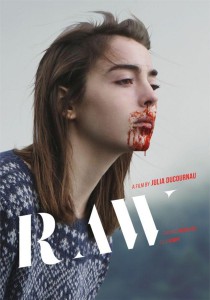 The most hotly anticipated film of the festival was RAW, not least because at previous screenings audience members had reportedly fainted, vomited or even required an ambulance. The Abertoir organisers were quietly sceptical, suggesting that even though it was a strong film, these reports may owe more than a little to marketing hype. Another possibility is that previous RAW previews drew in a lot of audiences unused to horror cinema in any form, as it’s a film with an obvious arthouse appeal. RAW is the story of an innocent teenaged vegan, who enrols at the same bizarre veterinary college as her wild-child older sister, where she discovers some primal appetites she struggles to contain. There is little doubt that the film’s writer and director, Julia Ducournau, believes her debut has a deep message. But is it about the power of feminine sexuality? Our place on the food chain? The folly of making a film when you don’t really have a story? It’s hard to say, and by the end – in my case at least – to care. I should confess at this point that I’m not much of a fan of the Franco-Belgian school of self-consciously transgressive, pseudo-intellectual horror to which RAW belongs. In fairness, RAW is interestingly shot, and isn’t as daftly pompous as MARTYRS or as tediously pretentious as AMER, and does have a welcome streak of black humour. If you’re wrinkling your nose at me slandering the above Francophone horror films – both regarded as classics in many quarters – then you may well get something out of RAW. But, while there were some arresting – even harrowing – scenes, the characters grate, and the script signs a series of plot cheques that the director has no intention of cashing.
The most hotly anticipated film of the festival was RAW, not least because at previous screenings audience members had reportedly fainted, vomited or even required an ambulance. The Abertoir organisers were quietly sceptical, suggesting that even though it was a strong film, these reports may owe more than a little to marketing hype. Another possibility is that previous RAW previews drew in a lot of audiences unused to horror cinema in any form, as it’s a film with an obvious arthouse appeal. RAW is the story of an innocent teenaged vegan, who enrols at the same bizarre veterinary college as her wild-child older sister, where she discovers some primal appetites she struggles to contain. There is little doubt that the film’s writer and director, Julia Ducournau, believes her debut has a deep message. But is it about the power of feminine sexuality? Our place on the food chain? The folly of making a film when you don’t really have a story? It’s hard to say, and by the end – in my case at least – to care. I should confess at this point that I’m not much of a fan of the Franco-Belgian school of self-consciously transgressive, pseudo-intellectual horror to which RAW belongs. In fairness, RAW is interestingly shot, and isn’t as daftly pompous as MARTYRS or as tediously pretentious as AMER, and does have a welcome streak of black humour. If you’re wrinkling your nose at me slandering the above Francophone horror films – both regarded as classics in many quarters – then you may well get something out of RAW. But, while there were some arresting – even harrowing – scenes, the characters grate, and the script signs a series of plot cheques that the director has no intention of cashing.
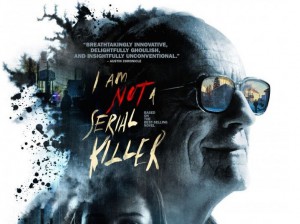
By way of contrast, I AM NOT A SERIAL KILLER takes a similarly unpromising premise – of a teenage outcast (Max Records) who his therapist is worried may become a criminal sociopath – and turns it into something wholly compelling and oddly warm. Our curiously likeable young anti-hero is convinced that the chilly backwater town where he lives is already being stalked by a serial killer, and resolves to stop try and stop them. The most familiar face on the cast comes in the shape of Christopher Lloyd as an elderly neighbour who befriends the troubled teen, and I’d say it’s a career best performance from the veteran actor. A miasma of quiet dread suffuses I AM NOT A SERIAL KILLER and while some weren’t convinced by the film’s final twist – which I’m not discussing here for obvious reasons – I rather liked the boldness of the climax. Chilling and funny by turns, I AM NOT A SERIAL KILLER takes a tired genre trope and turns it into something witty and authentically original, a tense study on just what turns men into monsters.
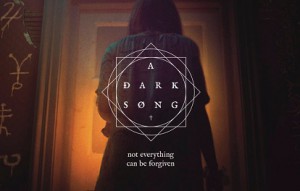 A DARK SONG is set in Wales, so was in a sense playing to a home crowd at Abertoir. It concerns a distraught woman who, destroyed by grief at the death of her son, seeks help from an occultist played by Steve Oram. Oram, perhaps best known for playing the gauche psychopath in the serial killer comedy SIGHTSEERS, plays his sorcerer very much against type – down-to-earth to the point of oafish – which lends a reality to this tale of mystic rites in an isolated country house. Ritual magic(k) has been touched upon in genre cinema a number of times before, but A DARK SONG’s scriptwriter has done more homework than most, delving into the demanding, meticulous, taboo-breaking ceremonies involved, designed to erode the practitioner’s contact with the everyday world of perceived reality. Like most savvy horror filmmakers on a tight budget, the director employs the small cast – it’s almost exclusively a two-handed affair – and limited sets to generate a sense of claustrophobia, as sanity slowly leaves the building. As many such filmmakers discover, however, skilfully building up the tension can create the need for a climactic final act that’s almost impossible to deliver, and A DARK SONG doesn’t quite satisfy in that department. For all that, it’s an interesting, intense film with a fresh angle on the familiar territory of occult horror.
A DARK SONG is set in Wales, so was in a sense playing to a home crowd at Abertoir. It concerns a distraught woman who, destroyed by grief at the death of her son, seeks help from an occultist played by Steve Oram. Oram, perhaps best known for playing the gauche psychopath in the serial killer comedy SIGHTSEERS, plays his sorcerer very much against type – down-to-earth to the point of oafish – which lends a reality to this tale of mystic rites in an isolated country house. Ritual magic(k) has been touched upon in genre cinema a number of times before, but A DARK SONG’s scriptwriter has done more homework than most, delving into the demanding, meticulous, taboo-breaking ceremonies involved, designed to erode the practitioner’s contact with the everyday world of perceived reality. Like most savvy horror filmmakers on a tight budget, the director employs the small cast – it’s almost exclusively a two-handed affair – and limited sets to generate a sense of claustrophobia, as sanity slowly leaves the building. As many such filmmakers discover, however, skilfully building up the tension can create the need for a climactic final act that’s almost impossible to deliver, and A DARK SONG doesn’t quite satisfy in that department. For all that, it’s an interesting, intense film with a fresh angle on the familiar territory of occult horror.
For more information on Abertoir, visit the festival site here.
Abertoir 2016 Part One – Restless Cadavers and Sociopathic Neighbours
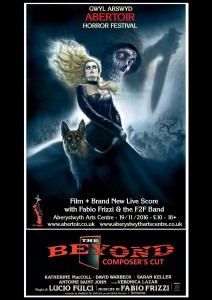 With the horror festival season now over for 2016, I thought I’d cast an eye over the new films I caught at this year’s Abertoir. I should emphasise here that this represents just a fraction of the diverse variety of entertainment on offer over the six day event. There was a selection of diverting horror-themed talks (including my own modest contribution) and two live Lovecraftian events (consisting of a performance by the impressive Duke St Workshop, and a one man show from the brilliant Michael Sabatton). And, as usual, a full programme of retro screenings of classic titles, from THE FLY and SHIVERS, to NEW YORK RIPPER and I DRINK YOUR BLOOD, plus a merry crew of special guests, such as b-movie queen Lynn Lowry, and soundtrack composing legend Fabio Frizzi, who debuted his new score for the 1981 cult zombie film THE BEYOND with a live band.
With the horror festival season now over for 2016, I thought I’d cast an eye over the new films I caught at this year’s Abertoir. I should emphasise here that this represents just a fraction of the diverse variety of entertainment on offer over the six day event. There was a selection of diverting horror-themed talks (including my own modest contribution) and two live Lovecraftian events (consisting of a performance by the impressive Duke St Workshop, and a one man show from the brilliant Michael Sabatton). And, as usual, a full programme of retro screenings of classic titles, from THE FLY and SHIVERS, to NEW YORK RIPPER and I DRINK YOUR BLOOD, plus a merry crew of special guests, such as b-movie queen Lynn Lowry, and soundtrack composing legend Fabio Frizzi, who debuted his new score for the 1981 cult zombie film THE BEYOND with a live band.
I must also confess that I didn’t catch every new film screened at Abertoir (the need for food, sleep, fresh air and sanity sometimes took precedence). But below are capsule reviews of the new films I did see. From a pragmatic point of view, this makes most sense, as while nobody reading this without a time machine can enjoy any of Abertoir 2016’s live events, the festival’s peerless programme of premiers reliably gives a good snapshot of the oustanding films for horror fans to look out for in coming months. Last year attendees enjoyed preview screenings of films that subsequently enjoyed critical acclaim – such as THE WITCH and BONE TOMAHAWK – and this year’s crop of international horror cinema also featured several titles surely destined to establish themselves as classics in years to come.
So, without further ado, a few new films from Abertoir 2016 to look out for in the coming months…
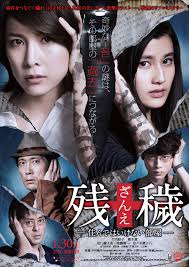 THE INERASABLE comes from Japanese cinema’s distinguished tradition of haunting, sophisticated ghost stories, stretching back to KWAIDAN in 1965. The film begins with a writer who specialises in investigating the paranormal experiences of her readers. One particular case – of a student troubled by a mysterious brushing sound in her apartment – begins our descent into a maze of interlinked tragedies and spectral consequences. THE INERASABLE has two underlying subtexts: That the spirit world operates to its own alien logic seperate to that of the daylight world, and that the supernatural is contagious, slowly infecting all those who encounter it. The story unwinds like a langorous serpent, with each coil drawing you further into its uncanny world. In truth, at times it can be hard to remain focussed on which thread we are supposed to be following, and casual viewers may find THE INERASABLE too drawn out, but for those with the patience to persevere, it is studded with impressively unnerving moments.
THE INERASABLE comes from Japanese cinema’s distinguished tradition of haunting, sophisticated ghost stories, stretching back to KWAIDAN in 1965. The film begins with a writer who specialises in investigating the paranormal experiences of her readers. One particular case – of a student troubled by a mysterious brushing sound in her apartment – begins our descent into a maze of interlinked tragedies and spectral consequences. THE INERASABLE has two underlying subtexts: That the spirit world operates to its own alien logic seperate to that of the daylight world, and that the supernatural is contagious, slowly infecting all those who encounter it. The story unwinds like a langorous serpent, with each coil drawing you further into its uncanny world. In truth, at times it can be hard to remain focussed on which thread we are supposed to be following, and casual viewers may find THE INERASABLE too drawn out, but for those with the patience to persevere, it is studded with impressively unnerving moments.
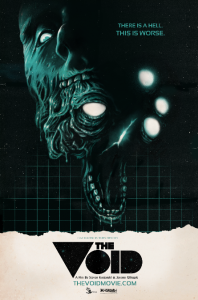 In THE VOID a police patrolman finds himself sheltering in a near-deserted smalltown hospital when it becomes clear that a local cult have broached a gate into an eldritch parallel dimension. A gushing love letter to the golden age of VHS horror of the 70s and 80s, THE VOID is peppered with visual and plot references to the work of American genre legends like Stuart Gordon and John Carpenter, as well as nods to Italian maestros of surrealist splatter like Lucio Fulci and Dario Argento. While I overheard some acccusations of plagiarism, for me these homages are delivered with such deftness and evident reverence and affection as to be impossible to resent or so readily dismiss. More importantly, you don’t need to know a thing about B-movie history to sit back and enjoy the punchy pacing and gobbets of old school gore and monster FX in THE VOID’s ferocious foray into Lovecraftian madness.
In THE VOID a police patrolman finds himself sheltering in a near-deserted smalltown hospital when it becomes clear that a local cult have broached a gate into an eldritch parallel dimension. A gushing love letter to the golden age of VHS horror of the 70s and 80s, THE VOID is peppered with visual and plot references to the work of American genre legends like Stuart Gordon and John Carpenter, as well as nods to Italian maestros of surrealist splatter like Lucio Fulci and Dario Argento. While I overheard some acccusations of plagiarism, for me these homages are delivered with such deftness and evident reverence and affection as to be impossible to resent or so readily dismiss. More importantly, you don’t need to know a thing about B-movie history to sit back and enjoy the punchy pacing and gobbets of old school gore and monster FX in THE VOID’s ferocious foray into Lovecraftian madness.
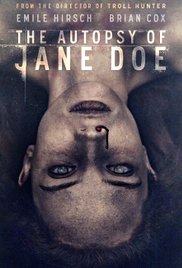 THE AUTOPSY OF JANE DOE takes place in a provincial American morgue that also doubles up as town crematorium. When the father and son team running the place take late-night delivery of an unidentified female corpse, it triggers a sequence of increasingly disturbing and inexplicable events. Quite unlike its director Andre Ovredal’s previous feature TROLLHUNTER, THE AUTOPSY OF JANE DOE is a masterclass in scalpel-sharp suspense and cloying formaldehyde atmosphere – exploiting his morbid setting’s potentrial for claustrophobic menace to the full – though things can suddenly get messily visceral when the story demands it. Brian Cox – now establishing himself as something of an unsung horror icon – takes the lead in an excellent cast, bringing warmth and believability to his portrayal of a brittle, but principled ageing pathologist. Despite very stiff competition, THE AUTOPSY OF JANE DOE won Abertoir 2016’s audience award for best new feature, a richly-deserved accolade for a film that deserves to be recognised as a genre classic.
THE AUTOPSY OF JANE DOE takes place in a provincial American morgue that also doubles up as town crematorium. When the father and son team running the place take late-night delivery of an unidentified female corpse, it triggers a sequence of increasingly disturbing and inexplicable events. Quite unlike its director Andre Ovredal’s previous feature TROLLHUNTER, THE AUTOPSY OF JANE DOE is a masterclass in scalpel-sharp suspense and cloying formaldehyde atmosphere – exploiting his morbid setting’s potentrial for claustrophobic menace to the full – though things can suddenly get messily visceral when the story demands it. Brian Cox – now establishing himself as something of an unsung horror icon – takes the lead in an excellent cast, bringing warmth and believability to his portrayal of a brittle, but principled ageing pathologist. Despite very stiff competition, THE AUTOPSY OF JANE DOE won Abertoir 2016’s audience award for best new feature, a richly-deserved accolade for a film that deserves to be recognised as a genre classic.

On the surface, CREEPY is a Japanese serial killer thriller in the HANNIBAL mould. In it, a police detective who specialises in psychological profiling sees a case go badly wrong, and quits the force to become a university lecturer in criminology. However, his past continues to haunt him, as he slowly begins to wonder whether the world of murder and madness he thought he’d escaped now resides right on his doorstep. I was with CREEPY for the first hour or so – it’s well made and keeps you on the edge of your seat with a mood of quiet, pervasive foreboding. However, it isn’t just a tense ride, but at 130 minutes a long one, and by halfway through the gaping plot holes and cockeyed character development begin to threaten to derail the whole film. Ultimately, director Kiyoshi Kurosawa might have done better to have opted either for a more straightforward straight police procedural crime film, or a more full-blooded foray into the suburban grotesque or perhaps even supernatural. As it stands, CREEPY tries to play both hands and doesn’t quite satisfy with either, making for a strong film that falls tantalisingly short of its potential.
So ends the first part of my capsule round up of Abertoir 2016’s finest. Check back in a couple of days for the second half.
Aberystwyth – It’s Like the Last Days of Rome Out There…
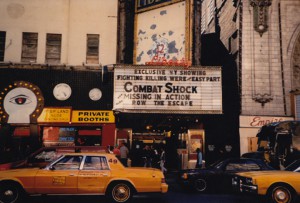 It’s that time of year when excited fear fans make the pilgrimage out to the westernmost fringes of the UK for Abertoir. This time, the Welsh horror festival is focussing its attention on New York’s 42nd Street. Not the popular musical, nor less the modern Disneyfied district around Time Square, rather the Deuce as it was once known, when the area was a sweaty Mecca for New York sleazehounds. Between the 1950s, and its revitalisation in the 90s, the Deuce was home to countless grindhouse theatres, screening the films too gory, crass or downright scuzzy for regular cinemas.
It’s that time of year when excited fear fans make the pilgrimage out to the westernmost fringes of the UK for Abertoir. This time, the Welsh horror festival is focussing its attention on New York’s 42nd Street. Not the popular musical, nor less the modern Disneyfied district around Time Square, rather the Deuce as it was once known, when the area was a sweaty Mecca for New York sleazehounds. Between the 1950s, and its revitalisation in the 90s, the Deuce was home to countless grindhouse theatres, screening the films too gory, crass or downright scuzzy for regular cinemas.
And for one week only, between 15-20th of November, Abertoir are bringing Manhattan’s heart of exploitation cinema back to life in the quaint Welsh town or Aberystwyth!
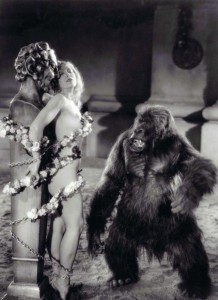 And, as ever, I’ll be there, lowering the tone yet further. This time I’ll be delivering a talk that tries to get to the very roots of the age-old association between cities and sin, digging deep into the worst history’s decadent urban sprawls have to offer the unwary traveller. There will be weird facts and swearing, there will be wild gesticulation, there will be antique dirty pictures. But that’s alright because rude pictures are okay, so long as everyone in them is dead… Hold on. That sounds wrong.
And, as ever, I’ll be there, lowering the tone yet further. This time I’ll be delivering a talk that tries to get to the very roots of the age-old association between cities and sin, digging deep into the worst history’s decadent urban sprawls have to offer the unwary traveller. There will be weird facts and swearing, there will be wild gesticulation, there will be antique dirty pictures. But that’s alright because rude pictures are okay, so long as everyone in them is dead… Hold on. That sounds wrong.
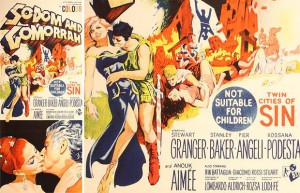 And for plenty more that sounds deeply wrong, join me at 2.15 on Thursday afternoon for my talk Beyond Sodom and Gomorrah, and witness the most foul-mouthed lecture on Mesopotamian social history ever attempted without the aid of a safety net.
And for plenty more that sounds deeply wrong, join me at 2.15 on Thursday afternoon for my talk Beyond Sodom and Gomorrah, and witness the most foul-mouthed lecture on Mesopotamian social history ever attempted without the aid of a safety net.

Even if my little performance doesn’t appeal, do check out the rest of the programme, for as ever the Abertoir organisers have excelled themselves. There’s a knockout roster of new horror films – such as Raw, The Love Witch, and The Void. Plus a feast of vintage grindouse – from I Drink Your Blood to The New York Ripper. There’s also theatre (including an adaptation of the Lovecraft tale Polaris) and a return for the soundtrack composer Fabio Frizzi after his triumphant performance at last year’s event. For further information, click here
Hope to see some of you there!…
Dare You Face… The Midlife Crisis of Dracula!
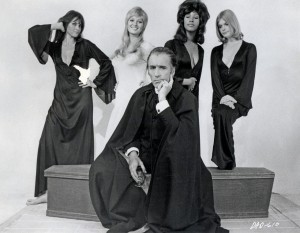 Unfortunately I was unable to deliver my talk at this year’s Bram Stoker International Film Festival. Happily, however, I will be at the Fear in the Fens event in Downham Market, Norfolk, this Saturday (November 5th) where I have the honour of being the day’s keynote speaker. I was initially asked to deliver my popular talk on Vlad the Impaler, Who are You Calling a Count?, which I first gave at Bram Stoker last year. However, upon reflection and discussion, I have updated and adapted the lecture to better suit the film I will be introducing. The film in question is Hammer’s toothsomely cheesy Dracula AD 1972, with my talk now entitled The Midlife Crisis of Dracula. In it, I investigate the strange case of what happened when legend’s immortal Prince of Darkness collided with the decade that taste forgot…
Unfortunately I was unable to deliver my talk at this year’s Bram Stoker International Film Festival. Happily, however, I will be at the Fear in the Fens event in Downham Market, Norfolk, this Saturday (November 5th) where I have the honour of being the day’s keynote speaker. I was initially asked to deliver my popular talk on Vlad the Impaler, Who are You Calling a Count?, which I first gave at Bram Stoker last year. However, upon reflection and discussion, I have updated and adapted the lecture to better suit the film I will be introducing. The film in question is Hammer’s toothsomely cheesy Dracula AD 1972, with my talk now entitled The Midlife Crisis of Dracula. In it, I investigate the strange case of what happened when legend’s immortal Prince of Darkness collided with the decade that taste forgot…
For further details of the event, click here for the official site, or indeed here for my own preview of Fear in the Fens. Meanwhile, for anyone who can’t make it to East Anglia this weekend, I shall soon be delivering another of my inimitable addresses on the opposite side of the country in Aberystwyth. More details presently…
York’s Little Box of Horrors
I come from the last generation that grew up wholly without the Internet. It almost seems strange now to reflect that my first book was researched without a single recourse to the Web. But of course the Internet changed everything. One offbeat example might be dreams…
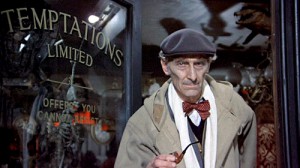 When I was younger one of my favourite recurring bitterwsweet dreams involved finding some magical shop down some hidden alleyway. Invariably it would be stuffed with wonderous treasures – toys usually initially – which I had never seen the like of. When I awoke, I was invariably struck with a melancholy sense of loss when I realised that the amazing place I had found and the incredible things I had found there weren’t real. Incidentally, my weakness for this notion explains why, perhaps, I remain so in love with the 70s horror film From Beyond the Grave, where the uncanny junk shop Temptations Ltd purveys surprises to luckless customers, presided over by the peerlessly creepy Peter Cushing.
When I was younger one of my favourite recurring bitterwsweet dreams involved finding some magical shop down some hidden alleyway. Invariably it would be stuffed with wonderous treasures – toys usually initially – which I had never seen the like of. When I awoke, I was invariably struck with a melancholy sense of loss when I realised that the amazing place I had found and the incredible things I had found there weren’t real. Incidentally, my weakness for this notion explains why, perhaps, I remain so in love with the 70s horror film From Beyond the Grave, where the uncanny junk shop Temptations Ltd purveys surprises to luckless customers, presided over by the peerlessly creepy Peter Cushing.
Meanwhile, happily, as I grew older, I discovered unique emporia off the beaten path which – if not as literally magical as those of my dreams – were still enchanted caves holding objects of desire wholly new to me. Best of all, they were real, and the things you took away in your shopping bags didn’t dissolve at the sound of an alarm clock. I’m thinking here in particular of the shops I found in the labyrinthine heart of London’s West End during me adolescence, such as the delightfully dingy heavy metal basement Shades, or the irresistibly-named Dark They Were and Golden Eyed with its treasure trove of horror magazines and monster memorabilia.
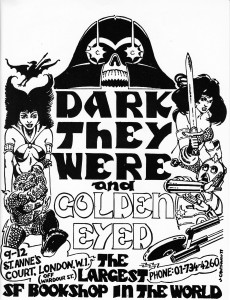
Both Shades and Dark They Were… are long gone, but I was struck on a recent visit to the West End by how all of their successors had also disappeared, with nothing springing up to replace them. Various factors are to blame, but the Internet has to be the biggest contributor to the demise of such truly special specialist shops. The initial discovery that Amazon, Ebay, Etsy and whatever now made most things accessible at the click of a mouse was intoxicating. But I was increasingly left with the wistful hangover of pondering what we may have lost, that perhaps that magic of discovery has gone forever…
Do modern kids dream about impossibly great web-sites which they can never find in their waking hours?
All of this has been a – rather rambling – preamble to something I wanted to publish on an enterprise that contradicts pretty much everything I’ve said over the last few paragraphs. Around last Halloween, a shop opened up here in the quaint and quirky, historical city of York which more than meets the qualifications I describe above for a truly magical space, full of wares that you didn’t know existed let alone that you wanted. It’s named Pandora’s Box.
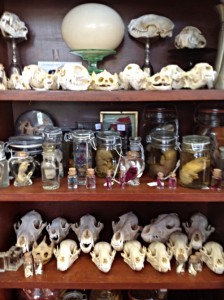
From a Vincent Price death-mask made from Belgian chocolate, to a lock of Charles Manson’s hair, or a baby’s-head candle, Pandora’s Box never fails to enchant, startle, intrigue and – on occasion – unsettle with it’s ever-rotating stock of offbeat curios, macabre ephemera and otherwordly oddities. I was immensely flattered when the owners Heather and Greg asked to stock some of my work, and Pandora’s Box is now the only shop on the planet where you can guarantee finding signed copies of my books.
You only have to look in the window to see that Pandora’s Box conceals myriad secrets and stories. So I resolved to quiz its proprietors on how the idea came together, and what it’s like managing such a unique venture. Heather – who is the friendly face behind the counter most days – answers most of the questions here, while her partner Greg prefers a more behind-the-scenes position…
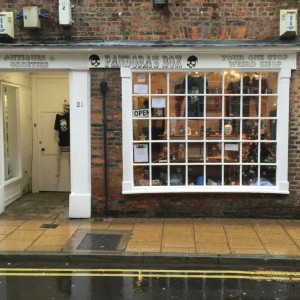
Why, when so many other businesses have migrated online, do you feel it’s important to have an old school bricks-and-mortar shop?
Heather I like the human experience. I like people. I like the eccentricities and sharing the knowledge of what we have with people. I like even the negative reactions to our collections. I mean I get mad of course when people are incredibly rude but if I can get them to see what I see, I feel so accomplished. Most importantly with the stuff we sell it is invaluable to have the hands on experience for the touch and feel of an object. Greg isn’t always such a big fan of humans.
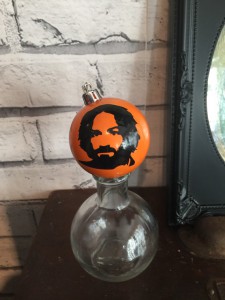 There’s little denying that a lot of what you sell – and indeed what I write about – could be described as morbid. Yet in my experience, ‘morbid’ people are often sensitive, kind and thoughtful souls. Is that your experience, and if so any thoughts on why that might be?
There’s little denying that a lot of what you sell – and indeed what I write about – could be described as morbid. Yet in my experience, ‘morbid’ people are often sensitive, kind and thoughtful souls. Is that your experience, and if so any thoughts on why that might be?
Heather I find that morbid people are kinder, more thoughtful and more genuine. I think morbidity comes from having a challenging life with more hardship and loss, you either become morbid and have a great sense of humour or you become a bitter asshole. Resilience goes a long way and humour makes people resilient, not sure which comes first. I think the macabre is actually beautiful.
Greg I agree that it’s true. They generally tend to recognise how fleeting stuff is and tend not to be too petty about anything.
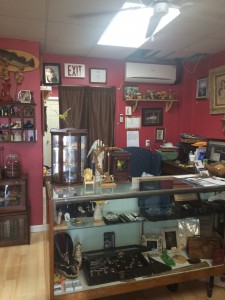
What’s the weirdest thing you’ve ever bought or sold? Have you ever been offered anything to buy you turned away because it was too much?
Heather So many things have passed through our fingertips. Probably the most beloved and weird was Ralph, a gorgeous diaphonized human fetus. We were afraid of the potential issues with shipping him over here when we moved. A small list of favourites: A drawing by Richard Ramirez, Ted bundy’s leg hair, forensic skulls, countless medical tools, specimens and collectibles.
I miss my antique elephant rib and Ralph the most.
Everything is too much money, this isn’t a get-rich kind of thing it’s a hobby gone mad.
We both reluctantly passed on a boot knife reputed to belong to Whitey Bulger as it was likely evidence since he was still wanted.
Greg misses the lion skull we had. It was a massive vintage female lion skull only 1/4 inch smaller than the record male lion. It was gorgeous and we only had that for a day before it sold.
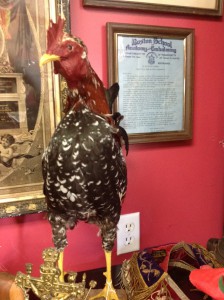
Is the morality of taxidermy an odd reflection on modern sensibilities? There are several supermarkets nearby filled with slaughtered animals in their chiller cabinets, yet people come into your shop and threaten you for selling stuffed animals that died of natural causes. Why do you think taxidermy makes some people so angry?
Heather Both of us think it’s lack of knowledge that makes people angry. They just don’t understand. They feel everything dead should be hidden away and forgotten like anything else unpleasant. I think some people tolerate certain objects in certain surroundings as well like in a museum and they can’t figure out how to categorise it outside of their neat little box. We embrace death and the beauty that is in it and the beauty after it.
I don’t believe in killing for art or taxidermy but generally death is unavoidable.
People just don’t know how to deal with death and instantly want to assume the absolute worst about people.
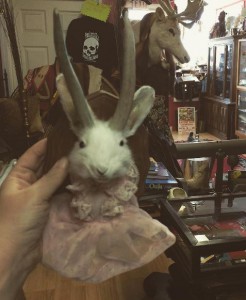
There is evidently a unifying theme or aesthetic behind Pandora’s Box, but it’s very hard to pin down. How might you define it? It strikes me that one element that many casual observers miss is a strong vein of black humour – am I onto something there?
Heather The unifying theme is us. When we pulled out of multidealer shops and markets and decided to sell in our own space back in 2011, we made a simple rule. If we didn’t love it, it wasn’t allowed in the shop. Many curiosity shops delve into weaponry, air plants or beard creams, we won’t do things to appeal to a market, we will unapologetically keep curating things like they are just for us. The shop and collections are like looking into our heads.
We absolutely crack ourselves up. There is so much humour in everything we do. Little pope dolls riding ferrets and a nun with a devil mask, a tiny gun in a priests hand, a stuffed deer with a pretty wig. Humour runs through everything and it does run dark.
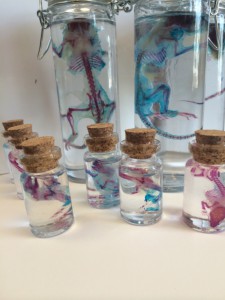 Do you have a ‘holy grail’ item? If there was one thing that somebody might bring into your shop that was your dream – or nightmare – piece, what would it be?
Do you have a ‘holy grail’ item? If there was one thing that somebody might bring into your shop that was your dream – or nightmare – piece, what would it be?
Heather We have a laundry list of things we want. Greg’s wish is an iconic extinct thing – beyond the passenger pigeon we had since he says that just looked like a pigeon – he wants a dodo or a thylacine or something magnificent. I tend to wish for everything I’ve ever sold back. I find the same things over and over because I love them so much and then tell myself I can keep the next one. I truly want another human diaphonized fetus as long as it’s as similar to Ralph as possible. I also would love a skeleton with rickets and a skull with syphlis but ask me tomorrow and my answer will change again. Anything and everything from an asylum gets both of us quite excited.
In addition to being a retail environment you can actually visit, Pandora’s Box also sell over the Internet for those who can’t make it to York. For those who can, they also offer a wide range of fascinating events and workshops, from taxidermy to tarot reading. I plan to collaborate with Heather and Greg on something pretty unique in the near future. For further details on all of this, and links to stay in touch with Pandora’s Box on Facebook Pinterest and such, click here.

